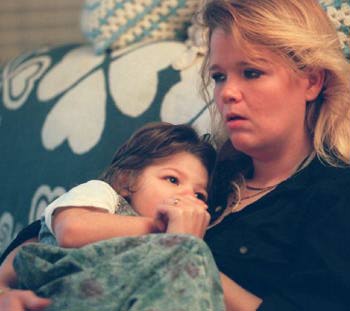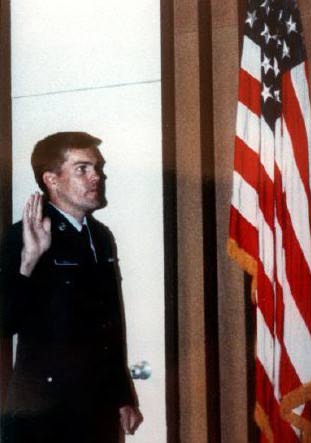
|

The military medical system leaves many lives shattered by substandard care and treatment |
 Valerie Kay Houck, 11, attends to her 5-year-old sister Emily as she takes a bottle. The family accused a military doctor of improperly treating an infection when Emily was an infant, causing brain damage. SKIP PETERSON/DAYTON DAILY NEWS |
By Russell Carollo Published: Sunday, October 5, 1997
A year-long Dayton Daily News examination found the U.S. military operates
a flawed and sometimes deadly health care system that lacks the most
significant safeguards protecting civilians from medical malpractice.
and Jeff Nesmith
DAYTON DAILY NEWS
Series - 1ST OF 7 PARTS
The newspaper reviewed thousands of previously unreleased government records, interviewed more than 200 people in 12 states and analyzed more than a dozen computer databases, some obtained only after a federal judge ordered the military to release them. The examination found:
* The military health care system is a magnet for problem doctors, offering them jobs without the burdensome restrictions and liabilities faced by civilian doctors. Military doctors are not required to have malpractice insurance, they do not have to be licensed in states where they practice and they are virtually immune from being sued by their patients.
* The military doesn't warn the public of doctors whose mistakes cause injuries and even death. More than 75 military medical facilities never reported a doctor for medical malpractice to a database created by Congressto protect the public from problem doctors. Those same facilities were the targets of claims alleging more than 1,000 incidents of medical malpractice, several involving deaths.
* At least 77 physicians without state medical licenses practiced in the services with "special" licenses issued only to doctors at military bases, Indian reservations, mental hospitals, prisons and labs handling organs for transplants. Nearly all the doctors either failed the state licensing exam or had no evidence in their files they took it. One failed 30 times.
* Nurses, physician assistants and even medical technicians take on greater responsibility in the military than in the civilian health care system. Deaths and injuries have been linked to this practice.
* Even with good doctors the system often fails. That's because there is little or no continuity of care. Patients rarely choose the doctor they see, and many get a different doctor at every appointment. The chances of getting a bad doctor increase with every visit.
"I think if Mom and Dad send their sons and daughters in harm's way, they have an expectation that the medical care afforded them is as close to what they'd get at home as can be expected," said Donald A. Kroll, an Air Force Reserve doctor who heads the military committee for the American Society of Anesthesiologists. "Are they getting what they get at home? No."
In a nine-page response to the newspaper's findings, Department of Defense health officials said differences between the civilian and military health care systems do not lesson the quality of care given to service members.
"Military medicine rates highly when measured against the variety of quality indicators used by industry to determine how well hospitals" perform," said John F. Mazzuchi, deputy assistant secretary of defense for clinical services. "The most important thing to us in military medicine is concern for the health and well-being of our patients."
Mazzuchi said the services have taken steps to correct two problems examined by newspaper.
The Department of Defense inspector general, he said, has initiated an audit to determine whether the services are following guidelines for reporting doctors linked to medical malpractice and misconduct. Mazzuchi also acknowledged that a number of military doctors practiced without proper licenses.
"We have initiated action to correct this situation," he said.
A secret system of medicine
The military operates one of the nation's largest health care systems, with 600 hospitals and clinics employing 147,000 medical professionals - about 13,000 of them doctors.The military's system offers free medical care to 8.2 million military family members and retirees. Yet it operates in virtual secrecy. Not only are military doctors immune from the most significant restraints and oversights placed on civilian doctors, but many of their mistakes are also shielded from public disclosure by laws and by the military's unique system of medicine.
Congress in 1986 passed a law prohibiting the release of any information about the quality of military doctors. Many states have similar laws, intended to encourage open discussions among doctors. But the military uses the federal law to protect the same types of information state medical boards release every day.
Because of the difficulty in getting records, it is impossible to know how many military doctors have histories of problems. Using several state and federal databases, the newspaper identified 200 doctors linked to incompetence and malpractice.
Dr. Archie D. Walden joined the Armywhile an investigation against him was pending in Minnesota, where he was accused of malpractice against at least 15 patients over a 14-year period. He was made a hospital commander in Germany.
Dr. Ubaldo P. Beato Jr. failed anatomy at the University of Santo Tomas in the Philippines, and he also failed exams for state medical licenses at least six times - in California, New Mexico, Florida and Oklahoma. The military made him chief of flight medicine at Sheppard Air Force Base, Texas, based on his "broad knowledge of the concepts and facets of preventive medicine in the United States Air Force."
Dr. Asa R. Talbot was accused of kissing a female patient coming out of anaesthesia and of sexually assaulting two other female patients, one a teen-ager. Two months after his civilian hospital privileges were put on probation, he joined the Army and wassent to Fort Campbell, Ky., where he was accused of sexually assaulting two female patients, who were 11 and 16 - crimes for which he was later convicted.
Dr. Henry T. Gunter was convicted in 1974 in California in the death of a patient undergoing an innovative sterilization procedure Gunter had never performed before. When the woman died, Gunter summoned another doctor back into the room and asked him, "What in hell are you doing?" The other doctor, California court records show, replied, "What am I doing? You killed the patient." Gunter joined the Army three years later, after he had trouble getting affordable malpractice insurance, and remained in the service until at least 1995.
Dr. Andrew Curtis Faire was linked in malpractice lawsuits to four patient deaths at William Beaumont Army Medical Center in El Paso, Texas. Three of the claims resulted in cash settlements with relatives. The fourth lawsuit was dismissed. Because Faire was a military doctor, he was never named as a defendant. The cases, by law, were filed in federal court against the United States government. Faire remains a physician at Beaumont.
Standards different despite requirement
The military first required its doctors to have licenses 10 years ago, following several highly publicized cases involving incompetent doctors in the military.The requirement was supposed to force military doctors to meet the same licensing standards as their civilian counterparts, but that isn't what happened
Civilian doctors must hold a license in the state where they practice. Because doctors in the military frequently are transferred and hundreds serve overseas, the military said its physicians could hold a license from any state, regardless of where they are stationed.
The new order sent hundreds of doctors scrambling for licenses.
The Virginia medical board found that Dr. Thomas J. Conage, an Air Force colonel, used someone else's license and continued as chief flight surgeon at Tinker Air Force Base, Okla., for six more months before he was reprimanded by the service. He continued to practice medicine in the military for nearly another year after that.
More than 1,100 military doctors - one of every 11 - still were not licensed as of last year, although most are interns and residents. And thousands of military doctors practice in states where they do not hold licenses.
Military doctors frequently are transferred and hundreds serve overseas, making it difficult for them to get a new license every time they are moved.
More than 200 Navy doctors went to Wisconsin, which doesn't have a major Navy installation. It did, however, have the cheapest licensing fee in the country: $68.
 Emily Houck's doctor still practices at a Georgia military
hospital. The federal government reached settlements for more than
$6 million with two of the doctor's patients in a 13-month period.
Pushing Emily in her $5,000 wheelchair is her sister, Kat-Mae, 7.
Emily Houck's doctor still practices at a Georgia military
hospital. The federal government reached settlements for more than
$6 million with two of the doctor's patients in a 13-month period.
Pushing Emily in her $5,000 wheelchair is her sister, Kat-Mae, 7.
SKIP PETERSON / DAYTON DAILY NEWS |
1 doctor, 2 children disabled for life
State medical boards have trouble overseeing doctors in the military because the boards were never designed to police physicians practicing outside their borders. Investigators in other states have no authority or funding to conduct investigations in other states, and many of the laws and safeguards written to strengthen the enforcement powers of state medical boards don't apply to military doctors.On May 18, 1992, the mother of a child who contracted meningitis filed a $10 million claim against the Navy, alleging Dr. Edner C. Monsanto, the chief pediatrician at the Navy base in Kings Bay, Ga., missed the diagnosis. The child is disabled for life. The Navy paid $2 million.
`We could find no quality review board that he went through that you would find in a civilian hospital after an incident,' said Joshua A. Whitman, a Jacksonville, Fla., attorney.
Georgia requires that such incidents be reported to the medical board through a variety of sources, including insurance companies.
"That would be a standard of care issue and an investigation would be launched,' said Kara Jones, spokeswoman for the Georgia medical board. "My opinion is that it would be brought to our attention.'
But Monsanto didn't have a Georgia medical license, and the $2 million wasn't paid by an insurance company. Taxpayers paid it.
"Federal licensees are going to be exempt from our jurisdiction,' Jones said. "We have to depend on the states that license them to discipline.'
The state that did license Monsanto - New York - didn't even require him to maintain an active registration there. Medical licenses are issued for life, but registrations must be renewed every two years, said Rita St. John, who oversees the disciplinary unit for the New York Division of Professional Licensing. She said Monsanto's registra;tion lapsed in February 1997, a violation of military guidelines and a reportable offense under the New York medical board rules -- had he worked in New York.
"A doctor who doesn't practice in New York doesn't have to maintain an active registration," she said.
Thirteen months after the Navy settled the meningitis case, it settled a case involving another injured child who had received treatment from Monsanto.
Emily Houck was taken to see Monsanto. She had tiny blisters on her head, and Monsanto suspected herpes, which could have been treated with a toothpaste-sized tube of ointment.
But he didn't give her the ointment. Four days later, Emily returned, running a fever and losing weight.
"Dr. Monsanto checked her and said she'll be fine," said Emily's mother, Debbie Houck. "Those were his exact words: She'll be fine. These words haunt me now."
 'She doesn't cry. She kind of yells. We've deciphered which yell is for what.' DEBBIE HOUCK mother of Emily Houck, 5. |
 SKIP PETERSON / DAYTON DAILY NEWS |
The fever she later developed damaged her brain. She cannot speak. She cannot walk. She cannot see. She cannot hear. She rarely smiles. She spends her days in a $5,000 wheelchair or rolling on the carpet.
"She does not cry. She kind of yells. We've deciphered which yell is for what," her mother said.
Attorney John S. Myers of St.Marys, Ga., sued the Navy and won $4.2 million for Emily and her family, bringing to more than $6 million the amount paid to Monsanto's patients by U.S. taxpayers in a 13-month period.
Monsanto still works at Kings Bay. He declined through a Navy spokeswoman to comment. However, the spokeswoman, Lt. Edie Rosenthal, said an investigation of the Emily Houck case concluded that Dr. Monsanto's actions met the standard of care. "The question of whether or not the standard of care has been met is open to medical debate; as in any inexact science, medical opinions vary," she said. " As a result it is possible for a case to be settled despite the fact that the investigation found that the standard of care was met.
In the meningitis case, Rosenthal said, an investigation concluded the standard of care was not met, and the case was reported to the National Practitioner Data Bank, which is used by hospitals across the United States to screen doctors. She said Monsanto's current license is in good standing with the state of New York.
States must trust military supervision
With doctors practicing so far from the states where they're licensed, state medical boards are forced to depend on the military for information. But the military is sometimes reluctant to criticize its doctors, even to state medical boards."It (the military) is a good opportunity for physicians with problems to hide out," said David Carr, who retired a few months ago as assistant director and chief of compliance for the Iowa Board of Medical Examiners. "If they're a long way away, there's no way to keep track of them."
Dr. Jerry L. Mothershead's Virginia medical board files shows he went to work in 1987 at a Norfolk, Va., emergency room after he'd been drinking. That same year, while still in the Navy, he got treatment, then reported to duty drunk again.
In 1988, he got more treatment, and in 1989, he started drinking again. Between 1991 and 1994, he reported a dozen episodes of drinking that lasted three-to-four days each. In March 1994, he got treatment. A year later, his urine tested positive for alcohol, prompting yet another treatment. In April 1995, Virginia medical board records say, he drank vodka for "approximately one week" before he was admitted to Portsmouth Naval Hospital.
In June 1996, Dr. W.A. McDonald, commander of the United States Navy Medical Corps, wrote to the Virginia medical board:
"I have seen no evidence that Dr. Mothershead's alcoholism has any current impact on his ability to practice medicine."
Mothershead is still in the Navy, working at Portsmouth Naval Hospital in Virginia. Mothershead didn't return a telephone call, but a Navy spokeswoman said he has been open and honest about his drinking.
"He knows he's got an alcohol problem," she said.
Department of Defense officials said the military handles doctors who abuse drugs or alcohol differently than civilian health officials do.
"Rather than reporting these individuals, we encourage them to seek treatment," says a written statement from military health officials. "The decision to approach this issue in this manner is based on the premise that colleagues will help one another to seek treatment much sooner than they will step forward to report such behavior in a fellow practitioner."
Military slow to report problem doctors to state
Even when the military does report doctors, the information is sometimes incomplete, or medical boards can wait years to get the reports."We get very little cooperation from the military in terms of providing records, like patient records," said Susan Miller, program administrator for the Colorado board. "We don't have authority over the military, the federal government, to force them to do that. We're just stuck."
The Colorado board file on Dr. David R. Harmon shows that while on duty as a third-year psychiatry resident at a Navy hospital in June 1993, he took a combination of drugs that made him unfit to see patients. In August, his drug problem became worse, and he was hospitalized for severe withdrawal symptoms.
On Aug. 13, 1993, the Navy officially sanctioned Harmon at an administrative proceeding with a fine and a punitive letter of reprimand. He was expelled from the residency program, and in May 1994, the Navy gave Harmon a general discharge under "honorable conditions."
The Colorado medical board would later determine that Harmon presented "a substantial danger to public health and safety." But the Navy didn't notify Colorado until September 1995, more than two years after taking action against him.
"That's unconscionable to wait that long," said Robert Holden of the Colorado attorney general's office.
In the meantime, Harmon came home to Colorado and began obtaining drugs illegally by using fictitious names or the names of friends.
"We just didn't know about it until two years later, when he got in trouble again," Miller said. "We didn't know because he didn't tell us like he was supposed to and neither did the military."
Harmon eventually was arrested.
"I'm aware of the fact that state boards have said they're having trouble getting records," said Dr. James R. Winn, executive vice president of the Federation of State Medical Boards. "He (the military doctor) agrees to quit if they don't report him, and they agree to go along with it."
A double standard for military doctors
Because of all the problems boards encountered policing military doctors, some states were forced to make a double standard: One for doctors in the state and a second, lower standard for those who aren't in the state."As long as they don't come back, we don't worry about them," said Ola Powers, who oversees medical licensing for the Virginia medical board. "We've got enough to worry about."
The license requirement for military doctors states that the license must be "active, not revoked, suspended or lapsed in registration."
Dr. Anastacio T. Salvador practiced in the Air Force with an inactive Maine license. When the Air Force reported him for "a trend of difficulties with care of complex and/or emergent cases," the Maine board found no need to discipline him because he held an inactive Maine medical license.
If a doctor licensed in New York doesn't renew his registration every two years, his name could be referred to the professional conduct office for possible action. If the same doctor is in the military working in another state, "We don't do anything," said St. John of the state's licensing division.
Salvador, who graduated from medical school in the Philippines, said the Air Force sometimes couldn't pay for courses doctors overseas needed to keep their licenses current. He said his problems began when the Air Force ordered him to work in the emergency room, moving him from an outpatient clinic where he saw patients with only minor illnesses.
"They don't have any emergency room physicians," he said. "I was telling them I was not qualified to do the emergency."
The Air Force, Salvador said, accused him in the deaths of two patients who had come to the clinic seeking his help. One died of a heart attack and the other died of a brain tumor.
Salvador now works as a civilian doctor for a North Carolina military center that processes recruits.
Patients often passed from doctor to doctor
Even highly qualified doctors sometimes have trouble providing the best care to their patients. That's because they're frequently asked to see patients they've never seen before, patients who've been passed from doctor to doctor. Some patients don't meet their surgeons until they are in the operating room or until the operation is over."They make no effort in my experience to try to match patients with doctors who know something about them," said Stephen Merrill, a former Navy claims officer and formerassistant U.S. Attorney in Virginia.
Tech. Sgt. Arthur A. Wells, who often bragged about the high quality of military medicine to the people he recruited into the Air Force, saw 11doctors in nearly three years of appointments at McChord Air Force Base, just outside of Tacoma, Wash. None found the cancer that eventually killed him.
Only five of the 10 reported board certification to the American Medical Association - four in family practice and one in orthopedics. None was identified by the American Board of Internal Medicine as a board certified cancer specialist.
"He went in 12 times in three years complaining of abdominal pains. . . . What gets me is after three years of going in, he never had an X-ray," said his wife, Pollyann Wells, who lives in Texas. "The thing was, he always saw somebody different."
 Tech. Sgt. Arthur A. Wells, who often bragged about the high quality of military medicine to people he recruited into the Air Force, saw 10 doctors in nearly three years of appointments at McChord Air Force Base, just outside of Tacoma, WA. None found the cancer that eventually killed him. |
* Feb. 4, 1992: doctor notes that Wells "has many stressors," including his
recruiting job, his wife's depression and having three children. Prescribes 2
tablespoons of Mylanta after meals and Tagamet.
* June 10, 1992: doctor notes Wells could have picked up an infection from
his son, prescribes more fluids and avoiding dairy products.
* Oct. 26, 1992: doctor diagnoses Wells as having infected sinuses and
prescribes Drixoral, an over-the-counter drug.
* March 17, 1993: doctor gives Wells a physical examination.
* March 22, 1993: doctor at acute care clinic checks chest and lungs,
prescribes Tylenol and liquids.
* Oct. 28, 1993: doctor notes Wells had sinusitis the previous year and
diagnosed him as having "acute sinusitis." Prescribed two antibiotics and a
cold medication.
* March 8, 1994: another physical examination.
* April 18, 1994: doctor notes that the stomach pains came after meals with
spices and coffee. The treatment: "Decrease coffee intake." He prescribed
Robitussin for his coughing and counseled him on heartburn.
* April 26, 1994: diagnoses heartburn and prescribed medication for it.
"My husband was so gung-ho military, he just wouldn't think that they wouldn't treat him well," Mrs. Wells said. "He would not question an officer. If they're enlisted men, they're afraid to question officers."
In January 1995, at Mrs. Wells' insistence, her husband was allowed to get a CAT scan at a nearby Army hospital. The scan found four tumors below his navel, the largest the size of a grapefruit, and two others the size of golf balls. There were too many tumors and too much spreading for doctors to operate.
He died on June 3, 1996, leaving a wife and three children.
"He loved the Air Force. He thought he was offering young people who had no other options good options," Mrs. Wells said. "The very thing they promised to do - which was take care of him - they didn't do.'